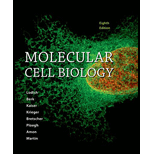
Concept explainers
To discuss:
The two basic requirements, needed for studying the type of protein synthesis and intercompartmental transfer in the pancreatic acinar cells and to find those two basic requirements and how the recent experiments meet these criteria.
Introduction:
The study of Palade and colleagues detected the location of newly synthesized amino acids by labeling them by "Pulse-chase Experiment". The cellular molecules change their location and features over time. The pulse chase reaction is one of the ways by which we can trace those compounds. First the molecules are "pulsed" i.e. exposed to labeled compound to study the pathway of the molecule.
The pathway is traced by the time it takes for the labeled compound to replace the unlabeled compound. In 1955, George Palade and his colleagues used this pulse-chase experiment to study the role of ER and Golgi in the protein synthesis. They conducted this study on the pancreatic cells as they are the major enzymes secreting cells. After this, new experiments were also conducted to study the pathway of protein transport but two basic requirements remained the same for all the experiments.
Explanation of Solution
The two basic requirements that are needed to study the intercompartmental protein transfer are given below:
- The amino acids should be labeled in the initial phase of protein transfer which will help in tracking the protein till the last phase.
- Inside the cell, the site of the labeled amino acid needs to be identified.
The recent experimental approaches employed to meet the criteria are as follows:
- GFP-Labelled (Green Fluorescent Protein) Protein:
A hybrid gene is formed when the membrane-bound glycoprotein is fused to the gene.The hybrid gene is encoded for green fluorescent protein. The temperature sensitive protein is not transported at restrictive temperature hence protein accumulates in the ER. At the favorable temperature, the protein moves out of the ER and enters the Golgi complex. Thus, the amount of time the protein takes before reaching the favorable temperature indicates the time protein stays in the organelle.
- Compartment-Specific Oligosaccharide Modification:
After the protein enters the Golgi complex, changes occur in the oligosaccharides. The enzyme Endoglycosidase acts on the oligosaccharides and leaves behind a residue of carbohydrate side chains. At restrictive temperature inside the ER, the protein is resistant to the action of Endoglycosidase enzyme. At the favorable temperature, the protein starts moving into Golgi as well as start getting hydrolyzed by the enzyme. From this, we come to know the time protein spends in the cell organelles.
Thus, the two basic necessities of the intercompartmental protein transfer and the new experimental methods to meet the above-said criteria have been discussed.
Want to see more full solutions like this?
 Human Anatomy & Physiology (11th Edition)BiologyISBN:9780134580999Author:Elaine N. Marieb, Katja N. HoehnPublisher:PEARSON
Human Anatomy & Physiology (11th Edition)BiologyISBN:9780134580999Author:Elaine N. Marieb, Katja N. HoehnPublisher:PEARSON Biology 2eBiologyISBN:9781947172517Author:Matthew Douglas, Jung Choi, Mary Ann ClarkPublisher:OpenStax
Biology 2eBiologyISBN:9781947172517Author:Matthew Douglas, Jung Choi, Mary Ann ClarkPublisher:OpenStax Anatomy & PhysiologyBiologyISBN:9781259398629Author:McKinley, Michael P., O'loughlin, Valerie Dean, Bidle, Theresa StouterPublisher:Mcgraw Hill Education,
Anatomy & PhysiologyBiologyISBN:9781259398629Author:McKinley, Michael P., O'loughlin, Valerie Dean, Bidle, Theresa StouterPublisher:Mcgraw Hill Education, Molecular Biology of the Cell (Sixth Edition)BiologyISBN:9780815344322Author:Bruce Alberts, Alexander D. Johnson, Julian Lewis, David Morgan, Martin Raff, Keith Roberts, Peter WalterPublisher:W. W. Norton & Company
Molecular Biology of the Cell (Sixth Edition)BiologyISBN:9780815344322Author:Bruce Alberts, Alexander D. Johnson, Julian Lewis, David Morgan, Martin Raff, Keith Roberts, Peter WalterPublisher:W. W. Norton & Company Laboratory Manual For Human Anatomy & PhysiologyBiologyISBN:9781260159363Author:Martin, Terry R., Prentice-craver, CynthiaPublisher:McGraw-Hill Publishing Co.
Laboratory Manual For Human Anatomy & PhysiologyBiologyISBN:9781260159363Author:Martin, Terry R., Prentice-craver, CynthiaPublisher:McGraw-Hill Publishing Co. Inquiry Into Life (16th Edition)BiologyISBN:9781260231700Author:Sylvia S. Mader, Michael WindelspechtPublisher:McGraw Hill Education
Inquiry Into Life (16th Edition)BiologyISBN:9781260231700Author:Sylvia S. Mader, Michael WindelspechtPublisher:McGraw Hill Education





